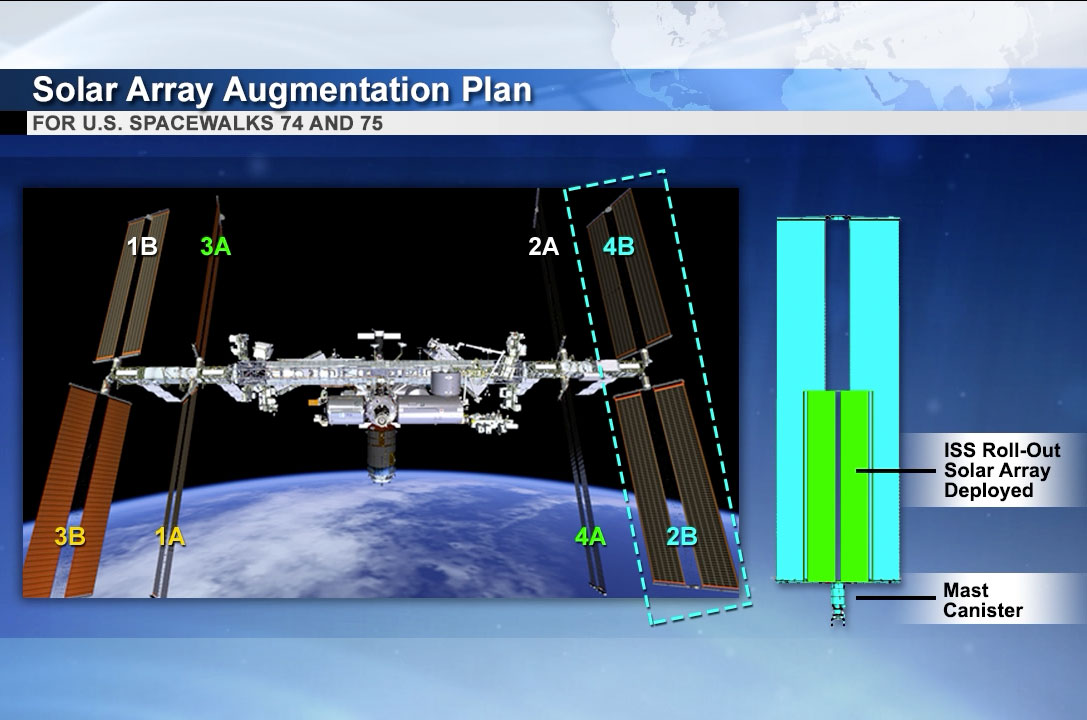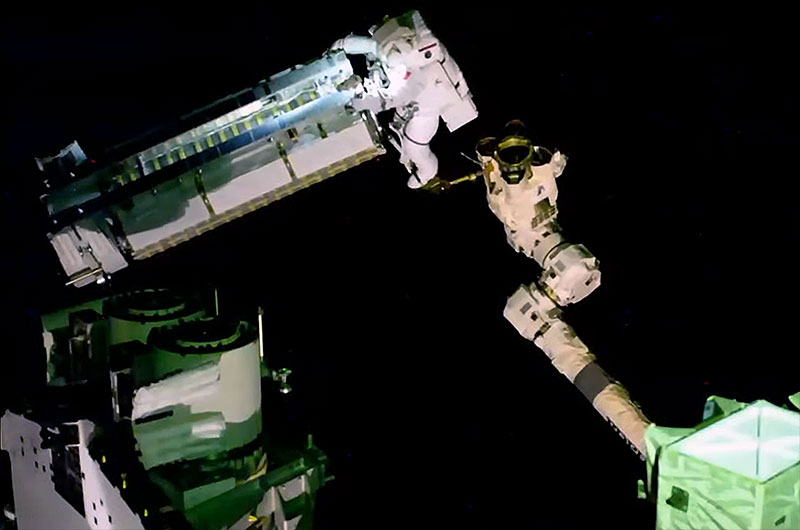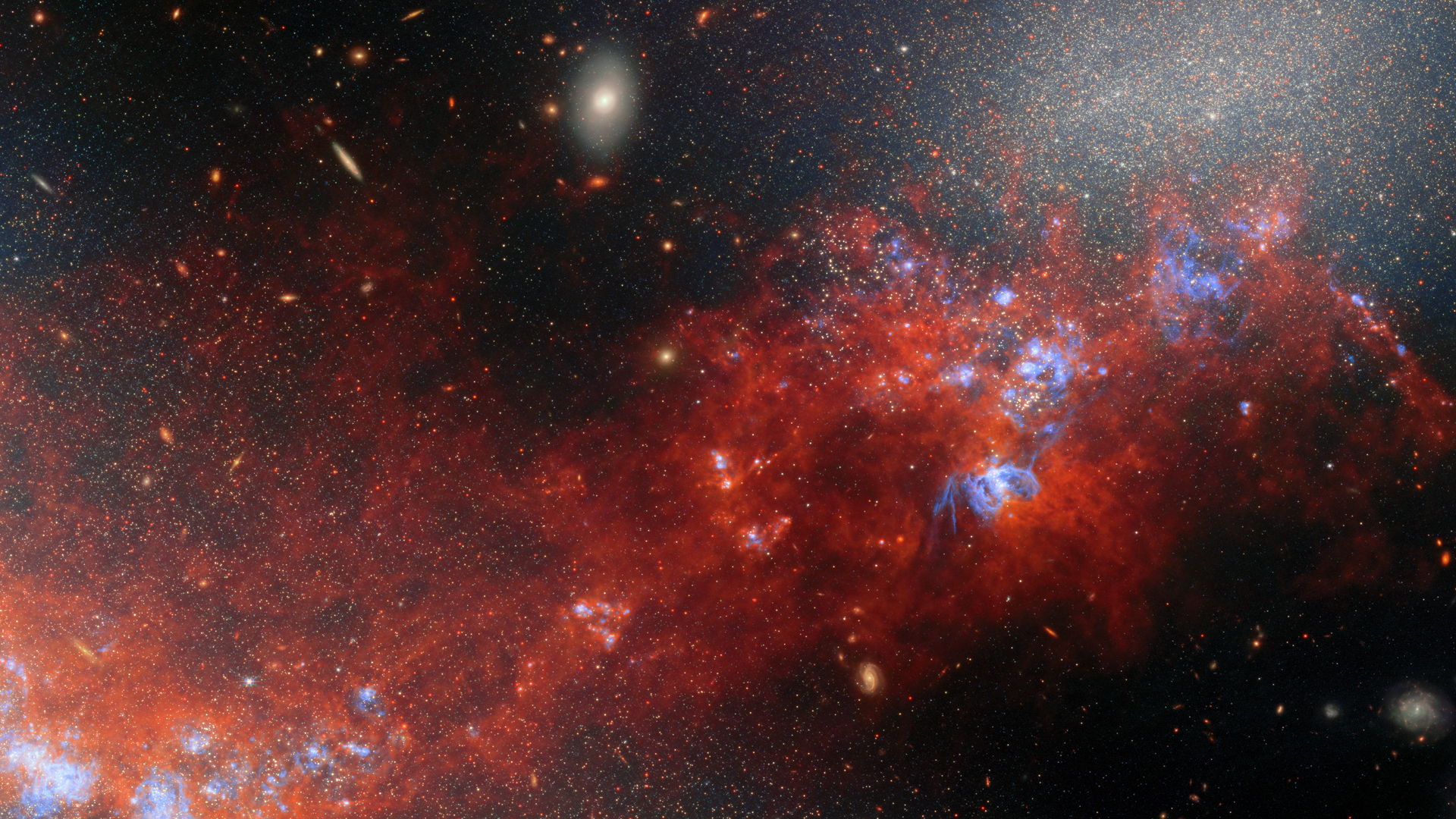Spacewalking astronauts run out of time to roll out first of new solar arrays on space station
Two astronauts set out to boost the power for the International Space Station, but ran out of time on their spacewalk before being able to roll out the first in a series of new solar arrays to augment the orbiting outpost's supply of electricity.
NASA astronaut Shane Kimbrough and Thomas Pesquet, a French astronaut with the European Space Agency (ESA), wrapped up their seven-hour and 15 minute spacewalk at 3:26 p.m. EDT (1926 GMT) on Wednesday (June 16), during which they partially installed the first of six more capable solar arrays. The spacewalkers attached the first of the ISS Roll-Out Solar Arrays (iROSA) in front of a 20-year-old array located on the far end of the left side of the space station's backbone truss.
"[Just as] on Earth, as years go by things get more efficient and smaller and this is no exception to that," said Kimbrough in a NASA interview previewing his and Pesquet's spacewalk. "These arrays are much smaller than the original arrays that we are going to go put these next to."
Related: Boeing to boost space station power supply with new solar arrays
Originally built with a design life of 15 years, the station's eight legacy solar array wings are beginning the show signs of degraded power production. Each of the new iROSAs is capable of generating 20 kilowatts of power. When used in tandem with the still-exposed areas on the older, larger arrays, the upgraded system will be capable of increasing the space station's electricity supply by 20% to 30%.
Provided by Deployable Space Systems (DSS) and prepared for installation on the station by Boeing, the first pair of iROSAs were launched on SpaceX's CRS-22 Dragon cargo spacecraft, which arrived at the orbiting laboratory on June 5. After beginning the spacewalk (extravehicular activity or EVA) at 8:11 a.m. EDT (1211 GMT), Kimbrough and Pesquet worked to release the first iROSA from the pallet where it was temporarily held and prepare the location where it would be installed.
Work on the array had to be paused, though, to allow time for Kimbrough to return to the airlock to reset his spacesuit's data display and to clear a minor pressure spike in his suit's cooling unit sublimator. After about an hour, and with Pesquet now attached to the end of the station's Canadarm2 robotic arm, the astronauts resumed their work, carefully passing the 750-lb. (340 kilograms) iROSA between them, carefully maneuvering the still-folded and rolled up array to the far port side of the station.
Breaking space news, the latest updates on rocket launches, skywatching events and more!
Video: Roll-out solar array prototype makes space station debut
Once it was in place at the canister at the base of the original P6/2B solar array, Pesquet and Kimbrough tried to unfold the iROSA to its 20-foot (6-meter) width, but ran into interference with another piece of equipment. Mission Control directed the astronauts to photo document the misalignment, re-fold the array and bolt it in place. The spacewalkers then returned to the airlock to reenter the space station.
Kimbrough and Pesquet were scheduled to perform another spacewalk Sunday (June 20) to deploy the second iROSA to augment the P6/4B solar array. NASA flight controllers will now work to replan the activities and timing of that EVA as is needed to complete the first array's installation before beginning the next.
In addition to assuring the space station has enough power to support its future needs, including expanded commercial activities, the iROSAs will also serve as a test for a similar set of roll-out solar arrays to be used at NASA's Artemis Gateway in orbit around the moon. The Gateway's ROSAs will be longer and be deployed remotely, without astronauts present, but otherwise will use the same technology as the station's iROSAs.
"The solar arrays are built by the same company, DSS, that we plan to use for the Gateway," said Dan Hartman, NASA's Gateway Program manager, during a pre-spacewalk briefing. "We're going to be watching the ISS EVA crew members and team go integrate these arrays over the existing arrays and certainly apply lessons learned that we have there."
Wednesday's spacewalk was the 239th in support of assembly and maintenance of the International Space Station. The EVA was the seventh for Kimbrough and the third for Pesquet. The pair, who arrived at the space station in April as Crew-2 members on SpaceX's Dragon Endeavour, previously conducted two spacewalks together in 2017.
Kimbrough has now logged 46 hours and 15 minutes working in the vacuum of space. Pesquet has totaled 19 hours and 47 minutes.
Follow collectSPACE.com on Facebook and on Twitter at @collectSPACE. Copyright 2021 collectSPACE.com. All rights reserved.

Robert Pearlman is a space historian, journalist and the founder and editor of collectSPACE.com, a daily news publication and community devoted to space history with a particular focus on how and where space exploration intersects with pop culture. Pearlman is also a contributing writer for Space.com and co-author of "Space Stations: The Art, Science, and Reality of Working in Space” published by Smithsonian Books in 2018.
In 2009, he was inducted into the U.S. Space Camp Hall of Fame in Huntsville, Alabama. In 2021, he was honored by the American Astronautical Society with the Ordway Award for Sustained Excellence in Spaceflight History. In 2023, the National Space Club Florida Committee recognized Pearlman with the Kolcum News and Communications Award for excellence in telling the space story along the Space Coast and throughout the world.



